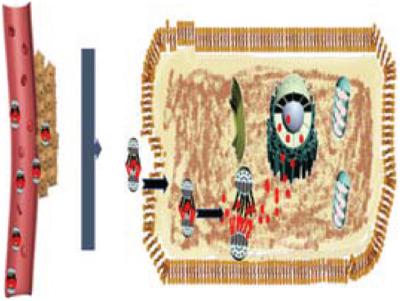当前位置:
X-MOL 学术
›
Macromol. Biosci.
›
论文详情
Our official English website, www.x-mol.net, welcomes your
feedback! (Note: you will need to create a separate account there.)
An Adjustable pH-Responsive Drug Delivery System Based on Self-Assembly Polypeptide-Modified Mesoporous Silica.
Macromolecular Bioscience ( IF 4.4 ) Pub Date : 2020-04-24 , DOI: 10.1002/mabi.202000034 Chunbo Yang 1 , Zhengzheng Shi 1 , Cong Feng 2 , Rui Li 1 , Sihao Luo 1 , Xiangfeng Li 2 , Liping Ruan 1
Macromolecular Bioscience ( IF 4.4 ) Pub Date : 2020-04-24 , DOI: 10.1002/mabi.202000034 Chunbo Yang 1 , Zhengzheng Shi 1 , Cong Feng 2 , Rui Li 1 , Sihao Luo 1 , Xiangfeng Li 2 , Liping Ruan 1
Affiliation

|
In this study, an adjustable pH‐responsive drug delivery system using mesoporous silica nanoparticles (MSNs) as the host materials and the modified polypeptides as the nanovalves is reported. Since the polypeptide can self‐assemble via electrostatic interaction at pH 7.4 and be disassembled by pH changes, the modified poly(l‐lysine) and poly(l‐glutamate) are utilized for pore blocking and opening in the study. Poly(l‐lysine)‐MSN (PLL‐MSN) and poly(l‐glutamate)‐MSN (PLG‐MSN) are synthesized via the ring opening polymerization of N‐carboxyanhydrides onto the surface of mesoporous silica nanoparticles. The successful modification of the polypeptide on MSN is proved by Zeta potential change, X‐ray photoelectron spectroscopy (XPS), solid state NMR, and MALDI‐TOF MS. In vitro simulated dye release studies show that PLL‐MSN and PLG‐MSN can successfully load the dye molecules. The release study shows that the controlled release can be constructed at different pH by adjusting the ratio of PLL‐MSN to PLG‐MSN. Cellular uptake study indicates that the drug is detected in both cytoplasm and nucleus, especially in the nucleus. In vitro cytotoxicity assay indicates that DOX loaded mixture nanoparticles (ratio of PLL‐MSN to PLG‐MSN is 1:1) can be triggered for drug release in HeLa cells, resulting in 88% of cell killing.
中文翻译:

基于自组装多肽修饰的介孔二氧化硅的可调pH响应药物递送系统。
在这项研究中,报道了一种使用中孔二氧化硅纳米颗粒(MSN)作为宿主材料,修饰多肽作为纳米阀的可调节pH响应的药物输送系统。由于多肽可以在pH 7.4下通过静电相互作用自组装并通过pH改变而分解,因此在研究中,修饰的聚l-赖氨酸和聚l-谷氨酸被用于孔的封闭和开放。Poly(l-赖氨酸)-MSN(PLL-MSN)和poly(l-谷氨酸)-MSN(PLG-MSN)是通过N-羧基酐在中孔二氧化硅纳米粒子表面上的开环聚合反应合成的。Zeta电位变化,X射线光电子能谱(XPS),固态NMR和MALDI-TOF MS证明了多肽在MSN上的成功修饰。体外模拟染料释放研究表明,PLL‐MSN和PLG‐MSN可以成功加载染料分子。释放研究表明,通过调节PLL-MSN与PLG-MSN的比例,可以在不同的pH值下构建控释。细胞摄取研究表明,在细胞质和细胞核中,尤其是在细胞核中都检测到了这种药物。体外细胞毒性试验表明,加载DOX的混合纳米颗粒(PLL‐MSN与PLG‐MSN之比为1:1)可以触发HeLa细胞中的药物释放,
更新日期:2020-04-24
中文翻译:

基于自组装多肽修饰的介孔二氧化硅的可调pH响应药物递送系统。
在这项研究中,报道了一种使用中孔二氧化硅纳米颗粒(MSN)作为宿主材料,修饰多肽作为纳米阀的可调节pH响应的药物输送系统。由于多肽可以在pH 7.4下通过静电相互作用自组装并通过pH改变而分解,因此在研究中,修饰的聚l-赖氨酸和聚l-谷氨酸被用于孔的封闭和开放。Poly(l-赖氨酸)-MSN(PLL-MSN)和poly(l-谷氨酸)-MSN(PLG-MSN)是通过N-羧基酐在中孔二氧化硅纳米粒子表面上的开环聚合反应合成的。Zeta电位变化,X射线光电子能谱(XPS),固态NMR和MALDI-TOF MS证明了多肽在MSN上的成功修饰。体外模拟染料释放研究表明,PLL‐MSN和PLG‐MSN可以成功加载染料分子。释放研究表明,通过调节PLL-MSN与PLG-MSN的比例,可以在不同的pH值下构建控释。细胞摄取研究表明,在细胞质和细胞核中,尤其是在细胞核中都检测到了这种药物。体外细胞毒性试验表明,加载DOX的混合纳米颗粒(PLL‐MSN与PLG‐MSN之比为1:1)可以触发HeLa细胞中的药物释放,











































 京公网安备 11010802027423号
京公网安备 11010802027423号